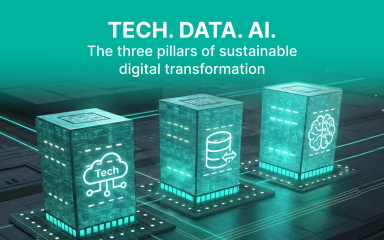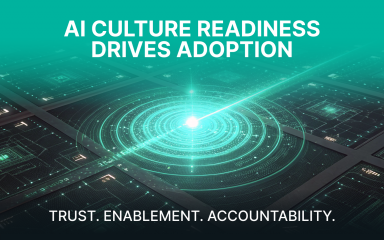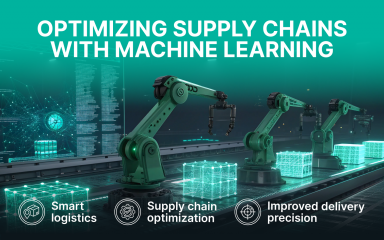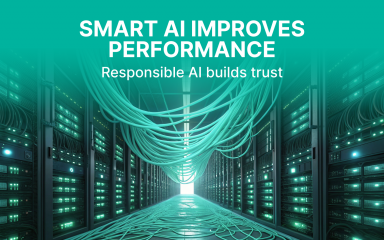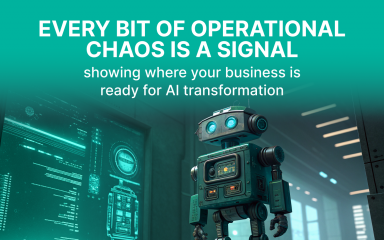Gen AI vs. AI is one of those phrases you’ve probably seen everywhere in 2025: on LinkedIn posts, in boardroom slides, and maybe even in late-night Slack debates. But what is Gen AI vs AI really about? More importantly, why should a business leader care?
Both AI and generative AI are major innovations within computer science, a foundational and interdisciplinary field that brings together biology, mathematics, neuroscience, and philosophy to solve real-world challenges and drive technological progress.
Here’s the short answer: traditional AI analyzes and predicts, while generative AI creates and innovates. Both are powerful, but they serve different purposes. Knowing the difference isn’t just trivia, but the key to choosing the right tools, avoiding wasted spend, and staying competitive in a market where AI adoption is no longer optional.
What Is the Difference Between AI and Generative AI?
The difference between AI and Generative AI comes down to their core functions:
- Traditional AI (sometimes called predictive AI) is designed to analyze data, recognize patterns, and make predictions or decisions. It’s about classification, optimization, and automation — think fraud detection, demand forecasting, or predictive maintenance. It thrives on structured data and supports decision-making by processing and extracting insights from existing data.
- Generative AI (Gen AI) goes further. Instead of only analyzing, it creates something new. Generative artificial intelligence is a specialized subfield of AI focused on creating original content such as images, audio, video, and text. It learns from large datasets and then generates text, images, video, code, or even synthetic data. In business, this means generating marketing copy, design prototypes, personalized customer experiences, or even research simulations.
That’s why the traditional AI vs. Gen AI distinction matters so much in 2025: businesses need both. One ensures accuracy and reliability. The other fuels innovation and personalization. Together, they define the future of enterprise AI strategy.
Understanding Traditional AI
First, let’s define traditional AI before we get into the whole generative AI thing. This is the type of artificial intelligence that businesses have been adopting for decades: the kind that analyzes data, finds patterns, and helps companies make better decisions. These advancements are the result of ongoing AI research aimed at solving real-world business challenges. From fraud detection to demand forecasting, traditional AI has quietly become the backbone of enterprise efficiency.
Brief History of AI
Early AI systems were rule-based, essentially advanced if/then statements. Later, machine learning models and neural networks allowed systems to learn from data instead of depending only on hard-coded rules. By the 2010s, deep learning drove breakthroughs in image recognition and natural language processing (NLP). Unlike traditional rule-based computing, AI evolves by continuously learning from new data, recognizing patterns, and adapting to new challenges.
Core Capabilities
Traditional AI excels at:
- Recommendation engines (“customers who bought this also bought…”)
- Image classification (spotting defects in a factory line, recognizing faces in security systems)
- Process automation (streamlining logistics, scheduling, or financial transactions)
These traditional AI examples rely on data analysis, rule-based logic, and pattern recognition rather than creativity. Traditional AI systems often depend on labeled data for supervised learning, where the correct answers are provided during the training process.
Traditional AI in Business
In enterprises, predictive AI has already proven itself:
- Fraud detection in finance
- Demand forecasting in retail
- Predictive maintenance in manufacturing
- Process automation across industries
Think of it as the ultimate “optimizer.” Traditional AI won’t design your next marketing campaign, but it will make sure your supply chain runs on time.
And the numbers back it up. The global artificial intelligence market size is projected to reach $757 billion in 2025, growing at a CAGR of 19.2% and potentially hitting $3.68 trillion by 2034. Software revenue alone will generate around $126 billion in 2025, a massive jump from just $10 billion in 2018, largely thanks to advances in deep learning, machine learning, NLP, and machine vision.
Adoption is accelerating, too. Around 78% of companies are already using AI in some form, with 71% reporting revenue gains in marketing and sales, 63% in supply chain, and 57% in service operations. The financial benefits are still moderate, often under 5%, but the impact is becoming real.
AI usage varies by sector: 63% of tech employees use AI daily, compared to 45% in financial services, 41% in professional services, and lower adoption in manufacturing (22%) and retail (19%). Meanwhile, voice technology is exploding, with forecasts of 8 billion AI-powered voice assistants by 2025: proof that AI is moving from back-end optimization into everyday customer interactions.
All of this shows that traditional AI is already reshaping industries, even if most companies are still early in their AI maturity journey.
What Is Generative AI?
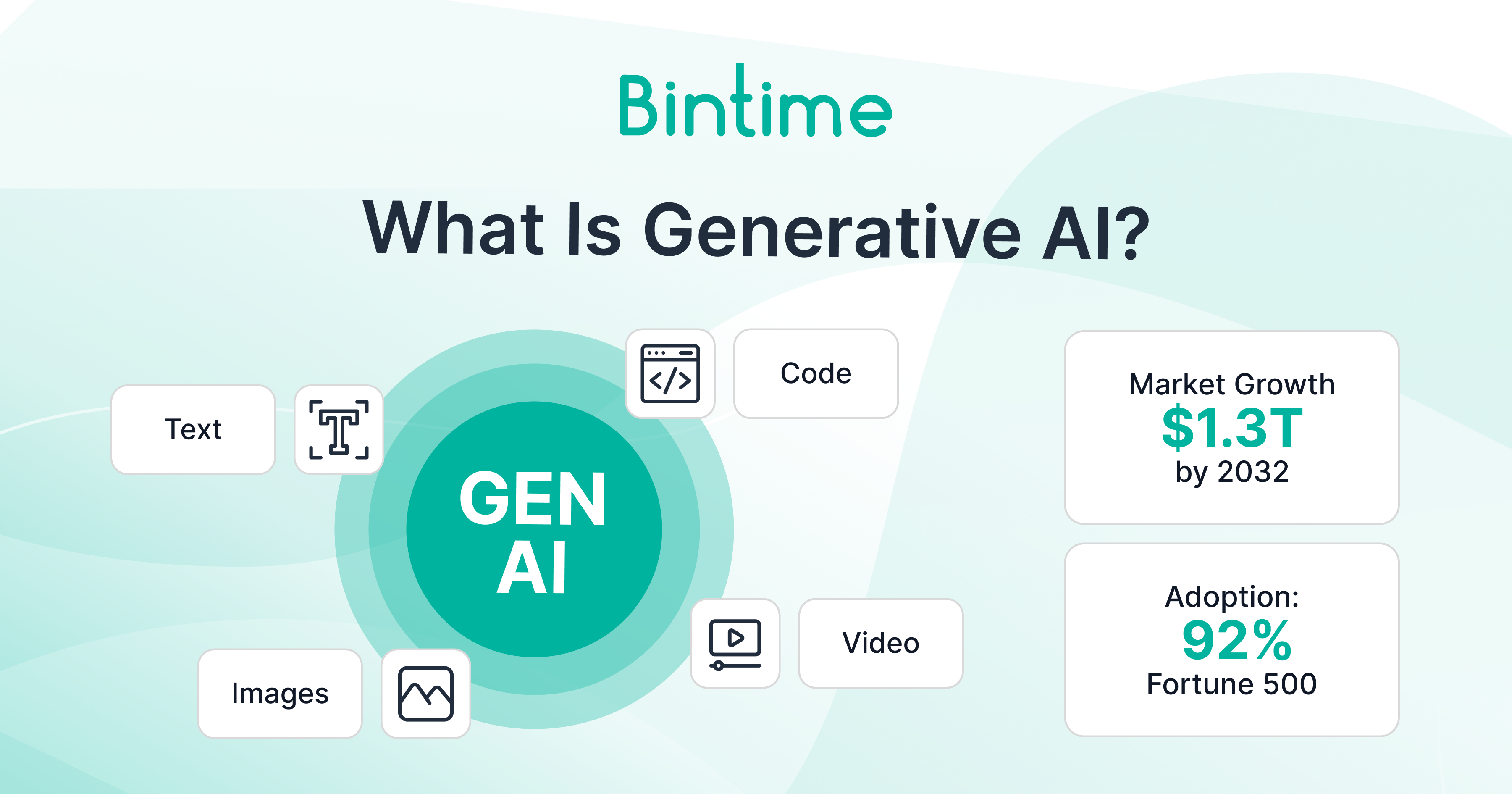 Unlike the older forms of AI that focus mainly on analyzing and predicting, generative AI is about creating something entirely new. It’s the reason we suddenly see AI tools writing articles, designing images, coding software, and even simulating conversations at a human level. In 2025, it’s a fast-growing market and a core driver of how businesses innovate, personalize, and scale.
Unlike the older forms of AI that focus mainly on analyzing and predicting, generative AI is about creating something entirely new. It’s the reason we suddenly see AI tools writing articles, designing images, coding software, and even simulating conversations at a human level. In 2025, it’s a fast-growing market and a core driver of how businesses innovate, personalize, and scale.
Generative artificial intelligence is a cutting-edge technology capable of creating original content, including images, text, and multimedia, with practical applications across various industries.
Generative AI Definition
Generative AI is a newer branch of artificial intelligence that doesn’t just process data: it creates new data. Instead of only telling you what’s likely to happen next, it can draft a blog post, generate product designs, simulate business scenarios, or even invent synthetic data for testing.
This is possible because generative models are trained on enormous volumes of training data. They learn patterns so well that they can mimic human intelligence in surprising ways, from producing natural text to generating realistic images.
And the scale is staggering. The global generative AI market is valued at $44.89 billion in 2025, up 54.7% from 2022, and is expected to top $66.62 billion by the end of 2025. Long term, it could surge to $1.3 trillion by 2032 with a CAGR of around 42%. Private investment has also poured in $33.9 billion globally, reflecting how quickly capital is chasing this trend.
Real-World Examples
Some generative AI tools you’ve probably heard of:
- ChatGPT and GPT-4/5 (text and conversation) — ChatGPT alone now has over 800 million weekly users and 4.6 billion monthly visitors.
- DALL·E, Midjourney, Stable Diffusion (image generation and design)
- GitHub Copilot (code generation)
- Runway or Synthesia (video production)
Adoption is skyrocketing. Around 92% of Fortune 500 companies and 95% of U.S. companies now use Gen AI tools. Industry adoption is especially strong in technology (88%), professional services, media, and telecommunications. The impact is already visible in customer service (chatbots), marketing, software engineering, and R&D, where companies report major productivity gains and cost reductions.
Gen AI vs. LLMs
A quick clarification: people often mix up Gen AI with large language models (LLMs). LLMs are one type of gen AI models: powerful ones trained on text to understand and generate language. But Gen AI also includes diffusion models for images, generative adversarial networks (GANs) for visuals, and other AI models that generate beyond text.
Why This Matters for Business
Generative AI isn’t just hype. It’s projected to add $2.6 to $4.4 trillion annually to the economy by 2030, while saving up to 300 billion work hours per year.
Of course, challenges remain. About 75% of companies struggle to find the in-house expertise needed to scale Gen AI, while concerns around data security and output quality persist. Still, with North America leading the market at 41% share, and adoption spreading fast, Gen AI is set to reshape how businesses innovate, personalize, and compete.
Generative AI vs. AI: Key Differences
When executives ask “what is Gen AI vs AI in practice?”, the best way to answer is through comparison. Traditional AI focuses on accuracy and efficiency, while generative AI unlocks creativity and personalization. The Gen AI vs traditional AI breakdown below makes the differences clear.
Architecture and Techniques
- Traditional AI: Uses deterministic, rule-based algorithms and machine learning models for classification, prediction, and automation. It thrives on structured tasks.
- Generative AI: Relies on deep learning methods like Generative Adversarial Networks (GANs), Variational Autoencoders (VAEs), transformers, and other very large models. These models are probabilistic and designed to generate original content such as text, images, music, or code. Gen AI works by leveraging artificial neural networks and complex systems that mimic biological neural systems, enabling the generation of new and diverse content.
Core Purpose
- Traditional AI: Answers questions like “What is this?” or “What will happen?” by analyzing input data and recognizing patterns.
- Generative AI: Answers “Create something new like this” by synthesizing fresh outputs from learned data patterns.
Type of Output
- Traditional AI: Produces classifications, predictions, recommendations, and insights.
- Generative AI: Creates original content, like articles, designs, videos, code, and synthetic data, none of which previously existed.
User Interaction
- Traditional AI: Works mostly behind the scenes. Users passively consume results (e.g., a credit score, a demand forecast).
- Generative AI: Encourages active collaboration. Users guide outcomes through prompts and iterative refinement.
Training and Data
- Traditional AI: Requires labeled, structured datasets and is focused on accuracy and precision.
- Generative AI: Trains on massive, diverse datasets, often unstructured, to generate contextually relevant and coherent content. Generative AI models can also leverage unlabeled data in unsupervised learning to identify patterns and generate new outputs.
Applications
- Traditional AI: Automation, fraud detection, demand forecasting, customer segmentation, predictive maintenance, and diagnostics.
- Generative AI: Content creation, design, software development, customer support chatbots, personalized marketing, and creative brainstorming.
Cost, Complexity, and Accessibility
- Traditional AI: Less resource-hungry, easier to scale for narrow use cases. But it demands specialized expertise and extensive data preparation.
- Generative AI: Expensive to train and maintain (requiring substantial computational resources). Yet, tools like APIs and gen AI models with natural language prompts make it more accessible to non-technical users.
Risks and Challenges
- Traditional AI: Risks include algorithmic bias, data privacy issues, and errors in prediction.
- Generative AI: Faces challenges such as hallucination (producing false or misleading outputs), copyright risks, and brand safety concerns.
Impact and Value
- Traditional AI: Delivers efficiency: automation, cost savings, and consistent decision-making.
- Generative AI: Drives creativity, content generation, and personalization. It enhances innovation and user engagement.
That’s the crux of the AI vs. Gen AI conversation: one predicts and optimizes; the other creates and collaborates. Both have distinct roles, and together, they form the backbone of enterprise AI strategies in 2025.
Generative AI vs. Traditional AI: Use Case Comparison
When it comes to real-world applications, the Gen AI vs. AI debate becomes much clearer. Traditional AI shines in structured, data-heavy tasks that require consistency and accuracy. Generative AI, on the other hand, steps in where creativity, adaptability, and personalization are needed.
| Business Challenge | Traditional AI | Generative AI |
| Customer support | Rule-based chatbots | Context-aware AI assistants |
| Product recommendations | Predictive ML algorithms | Generative flows with personalization |
| Inventory forecasting | Forecasting models | ERP-integrated Gen AI prompts |
| Content creation | Not applicable | Automated text, code, image creation |
| Talent acquisition | Resume filtering | AI interview agents with real-time reasoning |
This table highlights AI vs generative AI use cases clearly: one solves with precision, the other adapts creatively. Traditional AI gives businesses the confidence of accuracy and efficiency, while generative AI opens doors to personalization, content creation, and entirely new ways of engaging customers. Used together, they don’t just optimize operations; they also spark innovation, making enterprises more competitive in 2025 and beyond.
Choosing the Right AI Approach for Your Business
When to Use Traditional AI
Use traditional AI if you need:
- Reliable predictive AI insights
- Automation for structured data tasks
- Low-error, high-accuracy operations
When to Use Generative AI
Choose Gen AI when:
- You need personalization at scale
- You’re automating content creation
- Innovation and adaptability matter more than predictability
Combining Both Approaches
Most enterprises won’t pick one or the other. The future is hybrid AI: fraud detection (traditional) paired with AI-powered personalization (generative). Together, they cover both efficiency and creativity.
Assessing AI Maturity
Before diving in, perform an AI maturity assessment:
- Do you have the data infrastructure?
- Can your teams manage sensitive data?
- Are you ready for new skills in AI governance and compliance?
Future Outlook: Generative AI’s Role in Enterprise Innovation
Technology Evolution
Expect generative AI trends in 2025 to include more diffusion models, synthetic data generation, and multimodal systems (text + image + voice).
Business Transformation
Generative AI will fuel business transformation by enabling faster prototyping, personalized customer journeys, and entirely new products or services. It’s less about replacing humans and more about boosting productivity by freeing employees for complex tasks that require judgment.
Regulatory and Ethical Considerations
With innovation comes responsibility. Expect tighter rules around healthcare data, patient data, GDPR compliance, and ethical use of AI applications. Enterprises must handle high-quality data carefully to stay compliant.
Flexible AI FAQ
What is the difference between predictive and generative AI?
Predictive AI analyzes data and makes forecasts. Generative AI creates new content. That’s the essence of the traditional AI vs Gen AI debate.
Does every business need generative AI?
Not necessarily. The Gen AI vs. other AI question depends on your goals. Some businesses thrive with traditional AI alone. Others need both.
What is the cost of implementing AI?
Costs vary: AI vs. gen AI implementations can range from thousands (niche predictive models) to millions (training very large models).
Can AI be both predictive and generative?
Yes. Many enterprises adopt a hybrid AI strategy, using both approaches depending on the challenge. That’s part of choosing AI strategy wisely.
Conclusion: Which AI Is Right for You?
Here’s the truth: there’s no winner in the generative AI vs. AI debate. Both matter. Traditional AI keeps your operations sharp, while Gen AI helps you innovate, generate content, and personalize at scale.
The real question isn’t “which is better?” Which fits your business needs right now, and where do you want to go next?
Ready to define your AI strategy for business? Let’s talk. Reach out to Bintime’s Partner Manager and explore the right roadmap for your enterprise.

